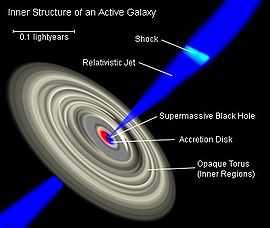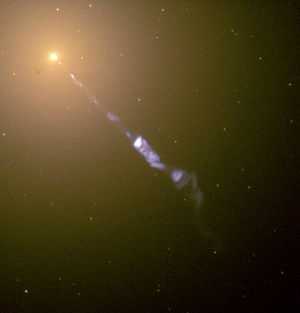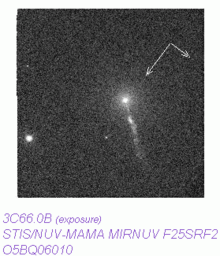Astrophysical jet
An astrophysical jet (hereafter 'jet') is a phenomenon often seen in astronomy, where streams of matter are emitted along the axis of rotation of a compact object. It is usually caused by the dynamic interactions within an accretion disc . When matter is emitted at speeds approaching the speed of light, these jets are called relativistic jets. The largest jets are those seen in active galaxies such as quasars and radio galaxies. Other systems which often contain jets include cataclysmic variable stars, X-ray binaries and T Tauri stars. Herbig–Haro objects are caused by the interaction of jets with the interstellar medium. Bipolar outflows or jets may also be associated with protostars (young, forming stars),[1] or with evolved post-AGB stars (often in the form of bipolar nebulae)
| Why do the discs surrounding certain objects, such as the centers of active galaxies, emit jets along their polar axes? |
While it is still the subject of ongoing research to understand how jets are formed and powered, the two most often proposed origins of this power are the central object (such as a black hole), and the accretion disc. Accretion discs around many stellar objects are able to produce jets, although those around a black hole are the fastest and most active. This is because the speed of the jet is around the same speed as the escape velocity of the central object. This makes the speed of a jet from an accreting black hole near the speed of light, while protostellar jets are much slower. While it is not known exactly how accretion discs manage to produce jets, they are thought to generate tangled magnetic fields that cause the jets to collimate. The hydrodynamics of a de Laval nozzle may also give a hint to the mechanisms involved.
One of the best ways of exploring how jets are produced is to determine the composition of the jets at a radius where they can be directly observed. For example, if a jet originates in the accretion disc, its plasma is likely to have electron-ion composition, whereas if it originates in the black hole it will likely be electron-positron in nature. Also, the plasma emits various forms of radiation such as X-rays and radio waves, which aid diagnosis.
Relativistic jet

Relativistic jets are extremely powerful jets[2] of plasma that are launched near central massive objects of some active galaxies, notably radio galaxies and quasars. Their lengths can reach several thousand[3] or even hundreds of thousands of light years.[4] The hypothesis is that the twisting of magnetic fields in the accretion disk collimates the outflow along the rotation axis of the central object, so that when conditions are suitable, a jet will emerge from each face of the accretion disk. If the jet is oriented along the line of sight to Earth, relativistic beaming will change its apparent brightness. The mechanics behind both the creation of the jets[5][6] and the composition of the jets[7] are still a matter of much debate in the scientific community; it is hypothesized that the jets are composed of an electrically neutral mixture of electrons, positrons, and protons in some proportion.

Similar jets, though on a much smaller scale, can develop around the accretion disks of neutron stars and stellar black holes. These systems are often called microquasars. An example is SS433, whose well-observed jet has a velocity of 0.23c, although other microquasars appear to have much higher (but less well measured) jet velocities. Even weaker and less-relativistic jets may be associated with many binary systems; the acceleration mechanism for these jets may be similar to the magnetic reconnection processes observed in the Earth's magnetosphere and the solar wind.
The general hypothesis among astrophysicists is that the formation of relativistic jets is the key to explaining the production of gamma-ray bursts. These jets have Lorentz factors of ~100 (that is, speeds of roughly 0.99995c), making them some of the swiftest celestial objects currently known.
Rotating black hole as energy source
Because of the enormous amount of energy needed to launch a relativistic jet, some jets are thought to be powered by spinning black holes. There are two well known theories for how the energy is transferred from the black hole to the jet.
- Blandford–Znajek process.[8] This is the most popular theory for the extraction of energy from the central black hole. The magnetic fields around the accretion disk are dragged by the spin of the black hole. The relativistic material is possibly launched by the tightening of the field lines.
- Penrose mechanism.[9] This extracts energy from a rotating black hole by frame dragging. This theory was later proven to be able to extract relativistic particle energy and momentum,[10] and subsequently shown to be a possible mechanism for the formation of jets.[11]
Other images
-

Centaurus A in x-rays showing the relativistic jet
-

The M87 jet seen by the Very Large Array in radio frequency (the viewing field is larger and rotated with respect to the above image).
See also
References
- ↑ http://www.astronomy.com/asy/default.aspx?c=a&id=6432
- ↑ Wehrle, A.E.; Zacharias, N.; Johnston, K. et al. (11 Feb 2009). "What is the structure of Relativistic Jets in AGN on Scales of Light Days?" (PDF).
- ↑ Biretta, J. (1999, January 6). Hubble Detects Faster-Than-Light Motion in Galaxy M87 (http://www.stsci.edu/ftp/science/m87/m87.html)
- ↑ Yale University - Office of Public Affairs (2006, June 20). Evidence for Ultra-Energetic Particles in Jet from Black Hole (http://web.archive.org/web/20080513034113/http://www.yale.edu/opa/newsr/06-06-20-01.all.html)
- ↑ Meier, L. M. (2003). The Theory and Simulation of Relativistic Jet Formation: Towards a Unified Model For Micro- and Macroquasars, 2003, New Astron. Rev. , 47, 667. (http://arxiv.org/abs/astro-ph/0312048)
- ↑ Semenov, V.S., Dyadechkin, S.A. and Punsly (2004, August 13). Simulations of Jets Driven by Black Hole Rotation. Science, 305, 978-980. (http://www.sciencemag.org/cgi/content/abstract/sci;305/5686/978?maxtoshow=&HITS=10&hits=10&RESULTFORMAT=&fulltext=relativistic+jet&searchid=1&FIRSTINDEX=10&resourcetype=HWCIT)
- ↑ Georganopoulos, M.; Kazanas, D.; Perlman, E.; Stecker, F. (2005) Bulk Comptonization of the Cosmic Microwave Background by Extragalactic Jets as a Probe of their Matter Content, The Astrophysical Journal , 625, 656. (http://arxiv.org/abs/astro-ph/0502201)
- ↑ Blandford, R. D., Znajek, R. L. (1977), Monthly Notices of the Royal Astronomical Society, 179, 433
- ↑ Penrose, R. (1969). Gravitational collapse: The role of general relativity. Nuovo Cimento Rivista, Numero Speciale 1, 252-276.
- ↑ R.K. Williams (1995). "Extracting x rays, Ύ rays, and relativistic e−e+ pairs from supermassive Kerr black holes using the Penrose mechanism". Physical Review 51 (10): 5387–5427. Bibcode:1995PhRvD..51.5387W. doi:10.1103/PhysRevD.51.5387.
- ↑ Williams, R. K. (2004, August 20). Collimated escaping vortical polar e−e+ jets intrinsically produced by rotating black holes and Penrose processes. The Astrophysical Journal, 611, 952-963. (http://arxiv.org/abs/astro-ph/0404135)
External links
- NASA - Ask an Astrophysicist: Black Hole Bipolar Jets
- SPACE.com - Twisted Physics: How Black Holes Spout Off
- Compact Objects and Accretion Disks
